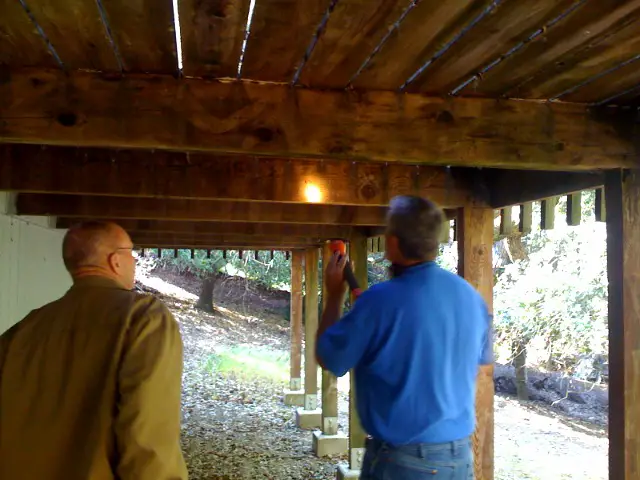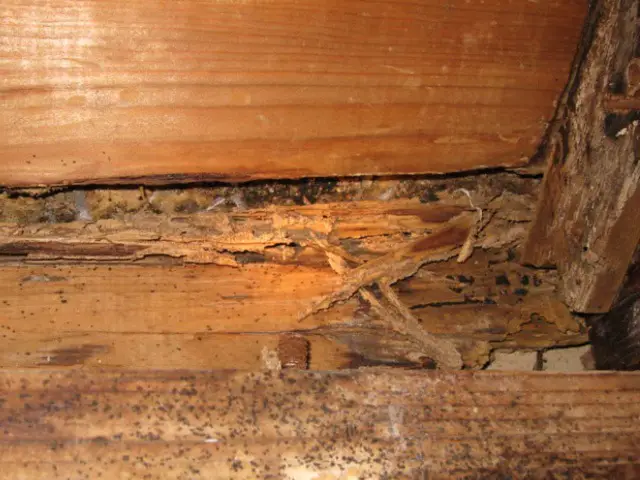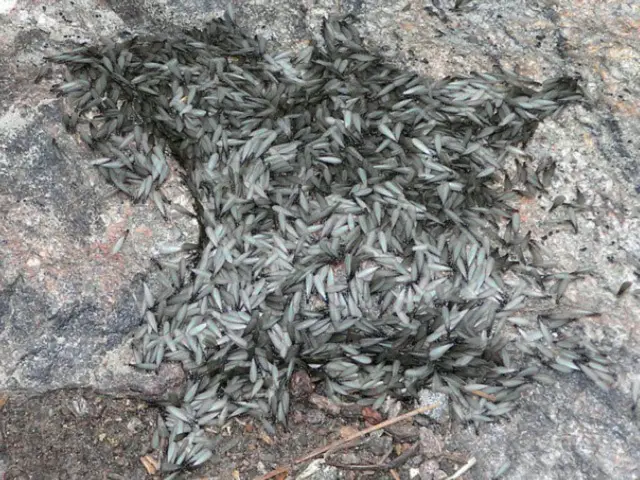How to get rid of Fire ants in the kitchen?
When Fire ants or Red imported fire ants invade your kitchen the natural reaction is to try to get rid of them. Fire ants can be a nuisance, especially when they are in the kitchen. If you want to get rid of ants in the kitchen you must first identify the species. The next thing is to find out the best way to get rid of the species of ants in your kitchen. Then it’s important to learn about the biology of the ant species and find out where they are likely to be nesting.
To rid your kitchen of fire ants, you should start by eliminating nests or colonies. People can spray insecticides on ant trails to get them out. But the result of this type of ant control is generally not the best because it only kills a small number of foraging worker ants. Getting rid of a few or even a hundred worker ants don’t get rid of colonies.
Fire ants enter your kitchen in search of a nesting place, food or water. There are steps you can take to get rid of ants in your kitchen:
- Keep your kitchen clean and take the trash out daily. Spilled foods and drinks serve as an easy food source for ants.
- Squirt some lemon juice on kitchen windowsills and cracks where the fire ants are getting in.
- Store food in ant-proof containers. Once inside your kitchen, easy access to food will attract more fire ants. Therefore, it’s important to store your food items in tightly sealed containers.
- Repair water leaks or any plumbing issues. Dripping plumbing or faucets attracts fire ants.
- Because ants are attracted to honeydew on plants, keep those plants to a minimum outside of your kitchen.
- Caulk even small cracks and crevices to keep fire ants out of your kitchen. Install new weatherstripping around kitchen windows.
- Be sure to check firewood for ants before bringing it into the house.
- Keep trash cans far from your house.
How to get rid of Fire ants outside naturally?
A natural way to get rid of ants outside naturally is to draw a chalk line around the entry points of your house. Fire ants are repelled by chalk or calcium carbonate. Calcium carbonate which is nothing more than the compressed shells of marine animals is an effective ant repellent.
Flour is another natural fire ant repellent. To get rid of ants sprinkle a line of flour along the backs of areas of ant activity. Apply lines of flour at your home’s entry points.
Use hot water to get rid of ants outside. Position an upside-down flowerpot over the anthill and pour boiling hot water through the drain. Using boiling water is an effective pest control method to get rid of anthills naturally.
Related posts:
- How To Get Rid Of Ants in Florida?
- How To Get Rid Of Ants in New York?
- How To Get Rid Of Ants In Pennsylvania?
- How To Get Rid Of Ants in Texas?
- How To Get Rid Of Ants in California?
- How To Get Rid Of Ants In Michigan?
- How To Get Rid Of Ants In Illinois?
- How To Get Rid Of Ants In Ohio?
- How To Get Rid Of Ants In Georgia?
- How To Get Rid Of Ants In North Carolina?
- Do Sugar Ants Bite?
How to get rid of Fire ants in the walls naturally?
Fire ants can find ways to get inside your walls. It’s a problem you should address immediately to minimize the damage. Colonies can damage your walls and cause major wood structure damage. If you see trails of foraging fire ants coming outside of walls, there is a good chance there is a nest inside. And if there isn’t one yet, there will be one soon. If you have ants in the walls you need to get rid of them to minimize the damage.
How to get rid of ants in the walls naturally? Getting rid of fire ants in walls is done by natural ant repellents:
- Silica – Diatomaceous earth, a type of silica, is a natural fire ant repellent. Silica is not a poison, but it kills ants and other insects. Diatomaceous earth absorbs the oils in fire ant skeletons, which dries the pests out.
- Pepper – Fire ants are irritated by the smell of pepper. Pepper is a natural ant repellent, and it’s completely safe to use in ant-infested walls.
- Vinegar – A 50-50 water and vinegar solution is an effective natural ant repellent.
How to get rid of Fire ants overnight?
To get rid of Fire ants overnight mix lavender or peppermint oil with water and spray the mixture in areas of ant infestation. Ants hate the smell of lavender and peppermint, making this a surefire way to get rid of Fire ants overnight.
How to get rid of Fire ants permanently?
You can use bait to get rid of ants in a matter or days. Eliminate wet or rotten wood outside your home. Keep the foundation of your house free from mulch or landscape rocks. Rocks, decomposing leaves and mulch keep the soil moist which attracts fire ants. Remove dense vegetation from around your home. Store firewood at least ten feet away from the house. Also, remove ivy growing on walls.
Clogged rain gutters serve as a natural nesting place for fire ants. Therefore, once a year, clean out rain gutters. Tree branches are natural bridges for ants. Cut back tree branches for the roof and outside walls, so fire ants cannot use them to get into your kitchen.
The Workings of a Fire Ant Colony
Hundreds to thousands of members can populate fire ant colonies. But, like the individual ants, the colonies will also pass through various cycles. For instance, a new colony will not have an obvious mound until it is well established for the first few months.
Older and more mature colonies will have mounds of up to three feet across. As the mounds or colonies grow in size, the fire ants will become more territorial and defend their territory aggressively.
The typical fire ant mound can be found in open, sunny areas. They are unlike other ant mounds in that they will not have a visible opening. Therefore, lawns, pastures, and fields are ideal places for fire ants to build their colonies. It is not unusual to find from 20 to more than 100 mounds in a single acre.
Mounds are built by the worker caste, with soil that is excavated from chambers far beneath the surface. This dirt is more than tunnel waste – it seals off the mass of tunnels found in a typical ant colony. As the sun warms the ground, the mounds will warm much faster, and the colony moves into the mound, bringing their brood with them to thrive on the heat of the day.
The ground is not the only place to find fire ant colonies. They have been known to take up residence in rotting logs, at the base of trees, or hidden under paved areas. At times, the ants have removed so much soil from underneath roads that the roads actually form sinkholes. Strangely enough, fire ant colonies have also been found on roofs, under debris on roofs or in electrical receptacles or boxes. They have an attraction to electrical impulses and like to live among wires, eating away at insulation and wire coverings. This often causes damage to electrical devices and power supplies.
Fire ants will tunnel deeper into the ground when it is scorching, trying to find relief from the heat and/or looking for water. It may appear that there are no ants in the mound. But after a heavy rain, disturbing the mound or drenching the mound will show you otherwise. A good way to see if there is an active colony in a mound is to simply place food, such as a potato chip or a piece of meat near the mound. You should soon see workers coming to forage for their new find.
Colonies are made up of workers and a queen. During some parts of the year, it may also contain males and females that are referred to as “reproductives.” These particular ants possess wings and will eventually take flight and reproduce to start new colonies. An average colony can contain somewhere between 100,000 to 500,000 workers, several hundred winged ants and several queens. Thus, a mature colony can produce up to 4,500 reproductives in a year’s time. The mating flights take place six to ten times a year.
Reproductives:
The mating takes place 300 to 2000 feet in the air when temperatures are between 70 and 95 degrees, the humidity is near 100%, and the wind is calm. A male reproductive has the sole responsibility to mate with the queen to keep the species alive. Male ants simply mate and then die, but the females will return to the ground after flying approximately two to three miles. They then remove their wings, locate a suitable area for nesting, and begin digging and laying eggs.
Initially, the nest will be a two to five-inch vertical tunnel. Interestingly, almost 99.9% of all females die before they can select a site for nesting. This is due to poor landing sites or predators. Therefore, the female fire ant will next seal the tunnel for about 30 days until the eggs begin to hatch. The nest will then be opened, and worker fire ants will begin foraging for food, rearing other workers, and tending to the queen’s needs.
However, that’s not the only way that new colonies get started. One study conducted by University of Texas-Austin post-graduate students found some interesting facts about the spread of fire ants. In the study, students dug up nests and carefully separated the queens from the other ants. Each queen was then ‘tagged’ with an ultra-thin colored wire that was tied around the ant’s waist. This would allow the students to readily identify the ants. The marked queens were then placed back into their environment. It was found that ant colonies were surprisingly also spread by a method called ‘budding.’ This meant they were different from other ant species that required a queen to move on and start a new nest. Instead, the imported fire ant colony would advance with several queens and a host of workers packing up and moving out to start a new colony.
The Queen:
The queen is the largest ant in the colony. Her primary responsibility is to lay eggs. A typical queen will produce between 1,500 to 1,600 eggs per day. The queen’s lifespan is about seven years long.
Workers will diligently and aggressively protect the queen. If the mound is disturbed in any way, the worker ants will instantaneously swarm on top of the mound for approximately eight minutes, assuring that nothing enters the mound.
If the disturbance continues, the workers then quickly escort the queen safely through underground tunnels to start a new colony. Note that some colonies are so big that there will be numerous queens within a single colony, with some having over a hundred in a single colony.
Workers:
The workers are sterile ants who…work. They build and repair the nest, care for the young, defend the nest, and feed both the young and adult ants. The workers do not live longer than one season.
Fire ant workers are different from other ant species in that they do not forage extensively above the ground but travel through underground tunnels to reach food sources. A worker fire ant’s duties differ depending on their size, but all of their duties more or less overlap. Age is also a determining factor in the worker’s duties. As the worker ants age, they will move from taking care of the brood in the central chambers to much more general-type duties away from the central area. They continue to move further and further toward the outside tunnels until the final weeks of their life when they will then leave the nest to forage for food and eventually die.
Reproductives:
The mating takes place 300 to 2000 feet in the air when temperatures are between 70 and 95 degrees, the humidity is near 100%, and the wind is calm. A male reproductive has the sole responsibility to mate with the queen to keep the species alive. Male ants simply mate and then die, but the females will return to the ground after flying approximately two to three miles. They then remove their wings, locate a suitable area for nesting, and begin digging and laying eggs.
Initially, the nest will be a two to five-inch vertical tunnel. Interestingly, almost 99.9% of all females die before they can select a site for nesting. This is due to poor landing sites or predators. The female fire ant will next seal the tunnel for about 30 days until the eggs begin to hatch. The nest will then be opened, and worker fire ants will begin foraging for food, rearing other workers, and tending to the queen’s needs.
However, that’s not the only way that new colonies get started. One study conducted by University of Texas-Austin post-graduate students found some interesting facts about the spread of fire ants. In the study, students dug up nests and carefully separated the queens from the other ants. Each queen was then ‘tagged’ with an ultra-thin colored wire that was tied around the ant’s waist. This would allow the students to readily identify the ants. The marked queens were then placed back into their environment. It was found that ant colonies were surprisingly also spread by a method called ‘budding.’ This meant they were different from other ant species that required a queen to move on and start a new nest. Instead, the imported fire ant colony would advance with several queens and a host of workers packing up and moving out to start a new colony.




